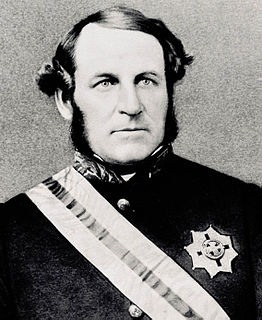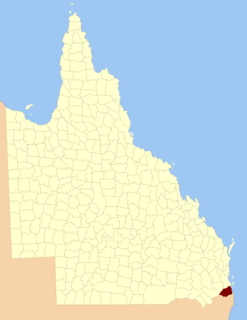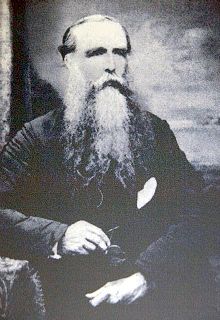The Separation of Queensland was an event in 1859 in which the land that forms the present-day State of Queensland in Australia was excised from the Colony of New South Wales and created as a separate Colony of Queensland.
The Separation of Queensland was an event in 1859 in which the land that forms the present-day State of Queensland in Australia was excised from the Colony of New South Wales and created as a separate Colony of Queensland.
European settlement of Queensland began in 1824 when Lieutenant Henry Miller, commanding a detachment of the 40th Regiment of Foot, founded a convict outpost at Redcliffe. The settlement was transferred to the north bank of the Brisbane River the following year and continued to operate as a penal establishment until 1842, when the remaining convicts were withdrawn and the district opened to free settlement. By then squatters had already established themselves on the Darling Downs, far distant from the seat of the New South Wales government in Sydney. Agitation soon commenced for the creation of a separate northern colony which could look after local interests, with the clamour being no less apparent in the fledgling township of Brisbane. [1]

In the vanguard of those seeking representative government was the Reverend John Dunmore Lang, representative for Moreton Bay in the New South Wales Legislative Council. Lang's call for the creation of a northern colony in 1844 was defeated in the Council by 26 votes to seven, and matters were held in abeyance until 1850 when the British Parliament passed the Australian Colonies Government Act, which enabled the creation of new Australian colonies with a similar form of government to New South Wales. In other words, they would have a bicameral parliament watched over by a vice-regal representative. Importantly, specifically mentioned were Port Phillip and Moreton Bay as districts which were likely to become colonies in the foreseeable future. The Act inspired Lang to renewed efforts, and between 1851 and 1854 he held nine meetings to gain further support for separation. He was, in fact, preaching to the converted as the inhabitants of the northern district had been increasingly neglected by the government in Sydney. [1]
Yet while they could reach consensus on the need for separation, whether a new colony would be free or unfree became a divisive issue. Lang and the majority of townspeople supporters favoured free immigration. The powerful squatting fraternity was heavily reliant on cheap labour and so advocated a renewal of convict transportation. While urban growth in Brisbane and Ipswich finally dictated for the former, there was still disagreement over where a new capital should be located. Brisbane, Toowoomba, Cleveland, Gayndah, Gladstone, Ipswich and Rockhampton were all potential candidates favoured by parochial interests. Brisbane eventually emerged victorious, and the reality of a new colony moved a step closer in 1856, when the British government agreed that the time was ripe to create a new northern colony. [1]

Among other things there was uncertainty over the location of a southern border. Lang was among many others who believed that the Northern Rivers should become part of a northern colony; the New South Wales Government disagreed, and when Queen Victoria finally signed the Letters Patent to create Queensland on 6 June 1859 at Osborne House, [2] the border was fixed at 28 degrees south.
The following month, unofficial news was received that the Secretary of State for the Colonies, Sir Edward Bulwer-Lytton, had appointed Sir George Bowen to be the colony's first Governor of Queensland. Bowen had recently served as Britain's Lord High Commissioner of the Ionian Islands near Greece, and was to have a distinguished career in the Colonial Office. While both the Letters Patent and the Order-in-Council appointing Bowen as Governor were duly published by the New South Wales Government, separation could not be accomplished until the Letters Patent had also been published in Queensland. As Governor Bowen was due to arrive on 6 December 1859 with the Letters Patent formally proclaiming the new colony, a reception committee was organised as early as September to arrange the celebrations. [1]



Inclement weather intervened meaning Governor Bowen did not arrive until the evening of 9 December 1859. The following day Governor and Lady Bowen were welcomed by an estimated crowd of 4,000 exultant colonists when they stepped ashore at the Botanic Gardens in Brisbane. [3] They were then conveyed by carriage to the temporary Government House, a building which now serves as the deanery of St John's Cathedral. After ascending to the balcony, the resident Supreme Court Judge, Justice Alfred Lutwyche administered Governor Bowen's oath, after which the Queen's Commission was read to the assembled throng by the newly appointed Colonial Secretary, Robert Herbert. The formalities concluded with the proclamation of the Letters Patent being read by Governor Bowen's acting private secretary, Abram Moriarty, who was to become the new colony's first civil servant after being appointed Under Colonial Secretary on 15 December 1859. [1]
The Letters Patent were published in the inaugural issue of the Queensland Government Gazette on 10 December 1859, and this has given rise to confusion over whether 10 December 1859 should be remembered as Separation Day or Proclamation Day. The former may be preferred, for it was only with the publication of the Letters Patent in Queensland that separation became a legal reality, though it can be equally accepted that this was also an official proclamation of their content. [1]
On 10 December 1859, Bowen also appointed an Executive Council to operate as a provisional government until a parliament had been elected. Under the terms of separation, however, it was left for Sir William Denison, Governor of New South Wales, to appoint 11 members to the first Queensland Legislative Council in May 1860 for a term of five years. Bowen was to appoint their successors for life, and from the outset the nominee character of the Upper House proved highly unpopular. Attempts to amend the Constitution to make the Upper House elected were to continue until the Legislative Council was finally abolished in 1922. [1]
However, the Queensland Legislative Assembly had 26 elected members sat for the first time on 22 May 1860. [4] In Queensland's first parliament, there was little evidence of the party politics, which would not begin to emerge until the second elections were held in 1863. Instead, they acted with a considerable degree of unanimity to pass legislation that set Queensland on its future course. The agenda largely revolved around land and immigration, primary and secondary education, extension of voting rights, state aid to religion, the census, transport, primary industry and the provision of labour. [1]
Queensland Day is celebrated on 6 June every year, the anniversary of Queen Victoria signing the Letters Patent to create Queensland on 6 June 1859.
In 2009, Queensland celebrated its sesquicentenary, known as Q150.
In 2009, as part of the Q150 celebrations, Queensland being proclaimed a new colony was announced as one of the Q150 Icons of Queensland for its role as a "Defining Moment". [5]

Queensland is a state situated in northeastern Australia, and is the second-largest and third-most populous Australian state. It is a federated state and a parliamentary constitutional monarchy, and is bordered by the Northern Territory, South Australia and New South Wales to the west, south-west and south respectively. To the east, Queensland is bordered by the Coral Sea and Pacific Ocean. To its north is the Torres Strait, separating the Australian mainland from Papua New Guinea. With an area of 1,852,642 square kilometres (715,309 sq mi), Queensland is the world's sixth-largest sub-national entity, and is larger than all but 15 countries. Due to its size, Queensland's geographical features and climates are diverse, including tropical rainforests, rivers, coral reefs, mountain ranges and sandy beaches in its tropical and sub-tropical coastal regions, as well as deserts and savanna in the semi-arid and desert climatic regions of its interior.

Sir George Ferguson Bowen, was an Irish author and colonial administrator whose appointments included postings to the Ionian Islands, Queensland, New Zealand, Victoria, Mauritius and Hong Kong.

The governors of the Australian states are the representatives of Australia's monarch in each of Australia's six states. The governors are the nominal chief executives of the states, performing the same constitutional and ceremonial functions at the state level as does the Governor-General of Australia at the national or federal level. The state governors are not subject to the constitutional authority of the governor-general, but are directly responsible to the monarch. In practice, with notable exceptions the governors are generally required by convention to act on the advice of the state premiers or the other members of a state's cabinet.

The Colony of New South Wales was a colony of the British Empire from 1788 to 1900, when it became a State of the Commonwealth of Australia. At its greatest extent, the colony of New South Wales included the present-day Australian states of New South Wales, Queensland, Victoria, Tasmania, and South Australia, the Northern Territory as well as New Zealand. The first "responsible" self-government of New South Wales was formed on 6 June 1856 with Sir Stuart Alexander Donaldson appointed by Governor Sir William Denison as its first Colonial Secretary.

The Supreme Court of Queensland is the highest court in the Australian State of Queensland.
North Australia can refer to a short-lived former British colony, a former federal territory of the Commonwealth of Australia, or a proposed state which would replace the current Northern Territory.

Arthur Macalister, was three times Premier of Queensland, Australia.

The County of Ward is a county in the south-eastern corner of Queensland, Australia. The main urban area within the county is the city of the Gold Coast, and it also extends to include the southern parts of the West Moreton region centred on Beaudesert and Boonah.

The first colonies of the British Empire on the continent of Australia were the penal colony of New South Wales, founded in 1788, and the Swan River Colony, founded in 1829. Over the next few decades, the colonies of New Zealand, Queensland, South Australia, Van Diemen's Land, and Victoria were created from New South Wales, as well as an aborted Colony of North Australia. On 1 January 1901, these colonies, excepting New Zealand, became states in the Commonwealth of Australia. Since federation, the internal borders have remained mostly stable, except for the creation of some territories with limited self-government: the Northern Territory from South Australia, to govern the vast, sparsely populated centre of the country; the split of the Northern Territory into Central Australia and North Australia, and then the quick merger of those back into the Northern Territory; and the Australian Capital Territory, a federal district ceded from New South Wales.
The following lists events that happened during 1824 in Australia.

The City of Ipswich is a local government area in Queensland, Australia, located in the southwest of the Brisbane metropolitan area, including the urban area surrounding the city of Ipswich and surrounding rural areas.
Queensland Day is officially celebrated on 6 June as the birthday of the Australian state of Queensland.

The Constitutional history of Australia is the history of Australia's foundational legal principles. Australia's legal origins as a nation state began in the colonial era, with its legal system reliant initially upon a legal fiction of terra nullius to impose British law upon the colony of New South Wales. As the colonies expanded, Australia gradually began to achieve de facto independence. Over the years as a result the foundations of the Australian legal system gradually began to shift. This culminated in the Australia Act, an act formally ending legal ties with the UK.

The Colony of Queensland was a colony of the British Empire from 1859 to 1901, when it became a State in the federal Commonwealth of Australia on 1 January 1901. At its greatest extent, the colony included the present-day State of Queensland, the Territory of Papua and the Coral Sea Islands Territory.

Robert Cribb (7 January 1805 – 16 April 1893) was an Australian parliamentarian who represented the district of East Moreton in the New South Wales Legislative Assembly, and the districts of Town of Brisbane and East Moreton in the Queensland Legislative Assembly after the separation of Queensland from New South Wales. Cribb's brother Benjamin Cribb also served as a member of the colonial parliaments of both New South Wales and Queensland.

Henry Challinor was a physician and politician in the Colony of Queensland.
This is a list of members of the New South Wales Legislative Council from 1851 to 1856. The 1851 Electoral Act increased the number of members in the Council to 54, 18 to be appointed and 36 elected. The initial appointments were made in October 1851.</ref>

The Electoral district of Counties of Gloucester, Macquarie, and Stanley and from 1851, Gloucester and Macquarie, was an electorate of the partially elected New South Wales Legislative Council, created for the first elections for the Council in 1843. The counties of Gloucester and Macquarie were the settled coastal areas north of Northumberland County, while the County of Stanley was the area surrounding Brisbane, in what became part of Queensland after its separation in 1859. Polling took place at Raymond Terrace, Port Macquarie, Dungog, Stroud, Brisbane, Ipswich and Mr Rowley's residence on the Manning River. The County of Stanley was removed from the district with the expansion of the Council in 1851 and became the districts of County of Stanley and Stanley Boroughs.

Francis Edward Bigge (1820—1915) was a pioneer pastoralist and politician in Queensland, Australia. He was a Member of the New South Wales Legislative Council and a Member of the Queensland Legislative Council. He championed the development of Cleveland on Moreton Bay. He was influential in achieving the separation of Queensland from New South Wales, but did not succeed in making Cleveland the capital of Queensland.

Queensland is the north-eastern state of Australia and has land borders with three other Australian states and territories: New South Wales, South Australia and Northern Territory. To the north of Queensland is the Torres Strait separating the Australian mainland from Papua New Guinea. To the east of Queensland is the Coral Sea, part of the Pacific Ocean. There are many islands off the Queensland coast which form part of the state of Queensland.
![]() This Wikipedia article was originally based on "The birth of modern Queensland" (2008) by Dr Murray Johnson published by the State of Queensland under CC-BY 3.0 AU licence (accessed on 10 February 2015, archived on 10 February 2015).
This Wikipedia article was originally based on "The birth of modern Queensland" (2008) by Dr Murray Johnson published by the State of Queensland under CC-BY 3.0 AU licence (accessed on 10 February 2015, archived on 10 February 2015).
| Wikimedia Commons has media related to Separation of Queensland . |